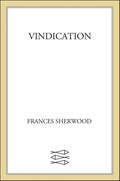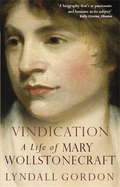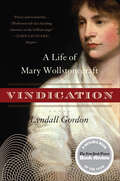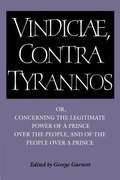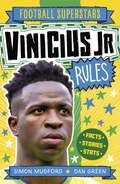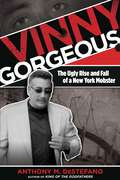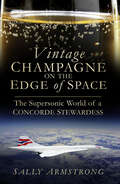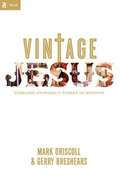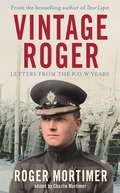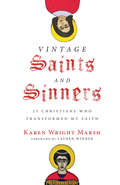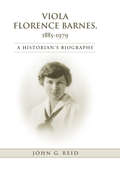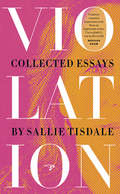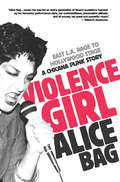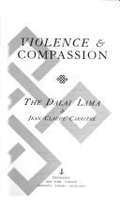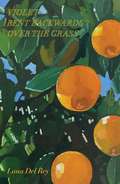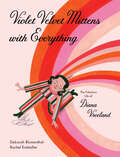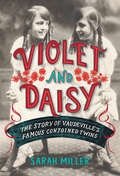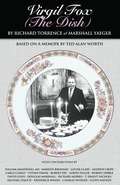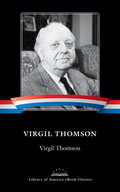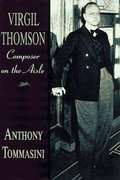- Table View
- List View
Vindication
by Frances SherwoodVindication is a prodigious, spectacular debut - a whirlwind of a novel that offers a passionate and surprising vision of life and love through the lens of the turbulent, romantic, often brutal eighteenth century."Sherwood's heralded debut is an arresting and convincing portrayal of Mary Wollstonecraft, the 18th-century author of The Vindication of the Rights of Woman and perhaps the first feminist. Lending her subject a modern sensibility, Sherwood describes Mary's wretched childhood, and follows her through the humiliation of demeaning jobs and chronic poverty." - Publishers Weekly
Vindication: A Life Of Mary
by Lyndall GordonIn this stunning new biography of the eighteenth-century writer Mary Wollstonecraft, Lyndall Gordon explores the life of a woman often criticised by biographers, historians and feminists alike. Gordon challenges such slanders, and portrays instead the genius of this extraordinary woman. The two-generation approach to her life examines not only Wollstonecraft herself, but also her effect on her daughters and heirs (Mary Shelley, Fanny Imlay, Claire Clairmont and Margaret Mount Cashell), and the ways in which they carried her influence into subsequent generations.Gordon takes stock of Wollstonecraft's life in accord with her own values rather than through the reputation history has given her. The author looks at her important relationships with Gilbert Imlay and William Godwin, and her ideas about issues such as the problems of communication between the sexes and parenthood. Through this brilliant study, Gordon, the author of biographies of Virginia Woolf and Charlotte Brontë among others, successfully reinterprets Mary Wollstonecraft for the twenty-first century.
Vindication: A Life Of Mary
by Lyndall GordonIn this stunning new biography of the eighteenth-century writer Mary Wollstonecraft, Lyndall Gordon explores the life of a woman often criticised by biographers, historians and feminists alike. Gordon challenges such slanders, and portrays instead the genius of this extraordinary woman. The two-generation approach to her life examines not only Wollstonecraft herself, but also her effect on her daughters and heirs (Mary Shelley, Fanny Imlay, Claire Clairmont and Margaret Mount Cashell), and the ways in which they carried her influence into subsequent generations.Gordon takes stock of Wollstonecraft's life in accord with her own values rather than through the reputation history has given her. The author looks at her important relationships with Gilbert Imlay and William Godwin, and her ideas about issues such as the problems of communication between the sexes and parenthood. Through this brilliant study, Gordon, the author of biographies of Virginia Woolf and Charlotte Brontë among others, successfully reinterprets Mary Wollstonecraft for the twenty-first century.
Vindication: A Life of Mary Wollstonecraft
by Lyndall Gordon“Wonderful, and deeply sobering. . . . Lyndall Gordon relates Wollstonecraft’s story with the same potent mixture of passion and reason her subject personified.”—New York Times Book ReviewThe founder of modern feminism, Mary Wollstonecraft (1759-1797) was the most famous woman in Europe and America in her time. Yet her reputation over the years has suffered—until now. Acclaimed biographer Lyndall Gordon mounts a spirited defense of this brilliant, unconventional woman who held strikingly modern notions of education, single motherhood, family responsibilities, working life, domestic affections, friendships, and sexual relationships.Offering a new interpretation for the 21st century, Gordon paints a vibrant, full portrait of Wollstonecraft, revealing how this remarkable woman’s genius reverberated through the generations, influencing not only her daughter, Mary Shelley, and other heirs, but early political philosophy in England and America as well—including the ideas of John and Abigail Adams.
Vindiciae, Contra Tyrannos: Or, Concerning the Legitimate Power of a Prince Over the People, and of the People Over a Prince (Cambridge Texts in the History of Political Thought)
by Stephanius Jurius Brutus George S. GarnettThe Vindiciae, contra tyrannos was the most infamous of the monarchomach treatises produced during the French wars of religion. This edition presents the first complete and accurate English translation of the work, a comprehensive apparatus, and an introduction that provides the first detailed analysis of the argument and also reconsiders the much-disputed question of authorship. It will be of interest to a wide range of scholars working on the history of political thought and early modern Europe.
Vinicius Jr Rules (Football Superstars #29)
by Simon MugfordIs Vinicius Jr your ultimate football hero? The Brazil winger and Real Madrid star has become a household name since scoring the winning goal in the 2022 UEFA Champions League final and partnering up with Jude Bellingham in 2023 to create the ultimate strike force. Read the amazing story of how Vini Jr honed his skills as a boy and caught the eyes of major scouts and has since followed in the footsteps of Pele, Ronaldo and Neymar Jr, primed to become a hero at the World Cup in 2026. Filled with lots of facts and stats, the inspiring narrative features fun cartoons, a simple narrative style and a cast of characters chipping in with quotes, jokes and comments.
Vinnie Ream: An American Sculptor
by Edward CooperAn intriguing biography of the American woman sculptor and Civil War–era Washington, DC, fixture. One of America&’s least known and most controversial women artists of the Civil War era was Vinnie Ream, who sculpted a bust of Abraham Lincoln from life when she was only sixteen years old and had almost no artistic training. She was able, through clever maneuvering and dogged determination, to achieve a commission from the Congress for a life-sized statue of the assassinated president—this despite the very real animus against women artists at that time, which is apparent in the heated arguments against granting her the Lincoln commission—arguments spearheaded in the Senate by Charles Sumner of Massachusetts. Steeped in the history of her time, Vinnie Ream was involved with dozens of senators and congressmen and other powerful men—not least of all Generals Sherman and Custer—and her studio on Capitol Hill became a legendary stopping place for many admirers and tourists. Her statue of Lincoln stands in the rotunda of the capitol building; her statue of Admiral Farragut stands in a Washington, DC, park; other works are in Statuary Hall and various museums. This is an engaging biography of a spirited female artist, and an effective portrait of Washington, DC, in the Civil War era. Praise for Vinnie Ream &“Ream&’s intellect, artistic talents, indomitable will, seductiveness, and grand ambitions were already evident when she was a teenager newly arrived in Washington, D.C. in 1861. . . . Endlessly intriguing. . . . Kudos to Cooper for resurrecting Ream and enriching so vividly the history of women in art.&” —Booklist&“A sharply focused biography, which skillfully exploits unpublished papers, journals and scrapbooks of Vinnie Ream.&” —New York Review of Books
Vinny Gorgeous: The Ugly Rise and Fall of a New York Mobster
by Anthony M. DeStefanoA vain man of good looks but no family ties to the Mob, Vincent &“Vinny Gorgeous&” Basciano worked his way up to acting boss of the Bonanno crime family, becoming its leader when official boss Joseph Massino went to prison in 2003. When the Mafia was crawling with secret operatives and informants caving to government pressure to flip, Basciano steadfastly obeyed the code of La Cosa Nostra. &“I got faith in one guy,&” he said during a secretly taped meeting. That man was Massino, head of the Bonanno borgata. But for all his loyalty, Basciano was still a hot-headed, cold-blooded killer, which ultimately led to his arrest and downfall.Then in a remarkable betrayal that rocked the Five Families to their foundations, Massino secretly cooperated with the FBI—the first head bossever to roll over. As a result, Basciano faced the death penalty, but a federal jury, disturbed by the prosecution&’s use of deadly criminal informants, reached a surprising verdict. Here from veteran crime author Anthony M. DeStefano comes the riveting story of the last true believer in the Mob&’s cult of brotherhood and his betrayal at the hands of the only man he ever trusted.
Vintage Champagne on the Edge of Space: The Supersonic World of a Concorde Stewardess
by Sally ArmstrongIn the era of Concorde, flying aboard this iconic aircraft was like being part of an elite club. Flying at the edge of space, seeing the curvature of the earth as well as jetting off to exotic locations on private charters were just normal parts of the job for Concorde employees. Sally Armstrong recounts her experiences as a stewardess flying with the rich and famous, meeting the superstars and royals, and ensuring their memories of flying on these special journeys were as special as they could be. Reflecting on Concorde’s near 30 years of service, from the heady beginnings to the tragic Air France Crash in 2001, the author also considers the important work of the Save Concorde Group. This book commemorates a unique era of flying with all the adventure, glamour and glitz that it entailed.
Vintage Jesus: Timeless Answers to Timely Questions
by Mark Driscoll Gerry BreshearsSome two thousand years after he walked the earth, Jesus Christ is still a hot topic. And for all the ridiculous, twisted, Da Vinci Code-esque conspiracy theories and lies about Jesus that have permeated popular culture and even the academy over the years, the truth about his character, nature, and work has not changed. So what exactly is the truth about Jesus Christ? That's the question the authors of Vintage Jesus seek to answer by breaking it down into a number of sub-questions about Jesus, including Is Jesus the only God? Why did Jesus come to earth? Did Jesus rise from death? Why should we worship Jesus? and others. Nonbelievers and new Christians looking to sit down and delve into the topic of Jesus, asking the toughest, most confounding questions they can think of, will find solid, biblical answers presented in a relevant, accessible way. "In a society where the Nicene Creed doesn't hold as much water as a tall Americano, Mark Driscoll and Gerry Breshears take an unabashed stance on biblical theology that comes as a refreshing yet timeless hyssop in response to a Christian sociological breakdown of truth." Brandon Ebel, President, Tooth & Nail Records. "Mark Driscoll and Gerry Breshears combine profound understanding of modern culture with weighty Christian doctrine that is faithful to the Bible. It's written in such an interesting style that it's hard to put down. I strongly recommend it!" Wayne Grudem, Research Professor of Bible and Theology, Phoenix Seminary, Phoenix, Arizona. "A great book about Jesus--yesterday, today, and forever relevant. The answers provided are right on and meaningful to everyone." Allen R. Weiss, President, Worldwide Operations, Walt Disney Parks and Resorts. "This book reveals Mark Driscoll as a highly powerful, colorful, down-to-earth catechist, targeting teens and twenty-somethings with the old, old story told in modern street-cred style. And Professor Breshears ballasts a sometimes lurid but consistently vivid presentation of basic truth about the Lord Jesus Christ." J. I. Packer, Board of Governors, Professor of Theology, Regent College. "Wow! This is a powerful book. It's edgy and, frankly, it made me uncomfortable at certain points but for the right reasons. We need light, not polish, over the story of Jesus, and that's exactly what this well-written and provocative work provides. It may make you squirm, but the strong biblical orientation and the crisp historic perspectives give you a context for that squirming!" Dan Wolgemuth, President, Youth for Christ/USA, Inc. "This book presents an honest view of Jesus without giving in to the pressure to soften him up. I had to grapple with the real vintage Jesus. This is a Savior worth fighting for." Matt Lindland, 2000 Olympic silver medalist in wrestling; top-ranked middleweight mixed martial arts fighter. "This new book by Driscoll, one of the most promising young pastors I've met, and his theological partner Gerry Breshears, tells the old, old story in a contemporary, exciting, in-your-face manner. Though written to appeal to today's younger seekers, nothing of classic Christian theology is omitted. Those of my generation may bridle at some aspects of the book--but it's good if we do. This book is just what's needed for us to understand how to reach the postmoderns and a great tool to help all of us connect with young seekers. This is both bold and uncompromising. I can highly recommend it." Chuck Colson, Founder, Prison Fellowship.
Vintage Roger: Letters from the POW Years
by Roger Mortimer'I never usually know what to give the men in my life but I've found the perfect book: VINTAGE ROGER by Roger Mortimer, a collection of letters from the author's war years. He manages to be hilariously funny, even about the most gruesome encounters. I laughed and cried and enjoyed every word' Jilly Cooper (Good Housekeeping festive pick)I think prison has done me very little harm and some good. I am now far better read, far less smug and conceited, far more tolerant and considerably more capable of looking after myself.In 1930, twenty-one-year-old Roger Mortimer was commissioned into the 3rd Battalion Coldstream Guards and spent the next eight years stationed at Chelsea Barracks. He lived a fairly leisurely existence, with his parents' house in Cadogan Square a stone's throw away, and pleasant afternoons were whiled away at the racecourse or a members' club. Admittedly things got a little tricky in Palestine in 1938, when Roger, now a captain, found himself amid the action in the Arab Revolt. The worst, however, was yet to come.In May 1940, while fighting the Germans with the British Expeditionary Force in the Battle of Belgium, he was knocked unconscious by an exploding shell. When he came round he was less than delighted to find that he was a prisoner of war. Thus began a period of incarceration that would last five long years, and which for Roger there seemed no conceivable end in sight.Vintage Roger is Roger Mortimer at his witty, irreverent best, exuding the charm and good humour that captured the nation's hearts in Dear Lupin and Dear Lumpy. Steadfastly optimistic and utterly captivating, these letters, written to his good friend Peggy Dunne from May 1940 to late 1944, paint a vivid portrait of life as a POW.
Vintage Roger: Letters from the POW Years
by Roger Mortimer'I never usually know what to give the men in my life but I've found the perfect book: VINTAGE ROGER by Roger Mortimer, a collection of letters from the author's war years. He manages to be hilariously funny, even about the most gruesome encounters. I laughed and cried and enjoyed every word' Jilly Cooper (Good Housekeeping festive pick)I think prison has done me very little harm and some good. I am now far better read, far less smug and conceited, far more tolerant and considerably more capable of looking after myself.In 1930, twenty-one-year-old Roger Mortimer was commissioned into the 3rd Battalion Coldstream Guards and spent the next eight years stationed at Chelsea Barracks. He lived a fairly leisurely existence, with his parents' house in Cadogan Square a stone's throw away, and pleasant afternoons were whiled away at the racecourse or a members' club. Admittedly things got a little tricky in Palestine in 1938, when Roger, now a captain, found himself amid the action in the Arab Revolt. The worst, however, was yet to come.In May 1940, while fighting the Germans with the British Expeditionary Force in the Battle of Belgium, he was knocked unconscious by an exploding shell. When he came round he was less than delighted to find that he was a prisoner of war. Thus began a period of incarceration that would last five long years, and which for Roger there seemed no conceivable end in sight.Vintage Roger is Roger Mortimer at his witty, irreverent best, exuding the charm and good humour that captured the nation's hearts in Dear Lupin and Dear Lumpy. Steadfastly optimistic and utterly captivating, these letters, written to his good friend Peggy Dunne from May 1940 to late 1944, paint a vivid portrait of life as a POW.
Vintage Saints and Sinners: 25 Christians Who Transformed My Faith
by Karen Wright Marsh15th Annual Outreach Magazine Resource of the Year - Inspirational 2017 Foreword INDIES Award Finalist Saints are people too. The word saint conjures up images of superstar Christians revered for their spectacular acts and otherworldly piety. But when we take a closer look at the lives of these spiritual heavyweights, we learn that they also experienced struggle, doubt, and heartache. In fact, we learn that in many ways they're not all that different from you and me. Narrating her own winding pilgrimage through faith, Karen Marsh reveals surprising lessons in everyday spirituality from these "saints"—folks who lived and breathed, and failed and followed God. Told with humor and vulnerability, Vintage Saints and Sinners introduces us afresh to twenty-five brothers and sisters who challenge and inspire us with their honest faith. Using the included conversation starters, you can join Karen on her journey with the likes of Augustine, Brother Lawrence, and Saint Francis, as well as Amanda Berry Smith, Søren Kierkegaard, Dorothy Day, Howard Thurman, Flannery O'Connor, and many more. Let their lives and their wisdom be an invitation to authentic life in Christ.
Viola Florence Barnes, 1885-1979
by John G. ReidViola Florence Barnes was one of the most prominent women historians in the United States from the 1920s to the 1950s. Born in 1885, Barnes was educated at Yale University and began teaching at Mount Holyoke College in 1919. She was an instrumental member of the 'imperial school' of historians, who interpreted North American colonial history within a British imperial framework. Specializing in New England and Canada's Maritime provinces, her best-known book was The Dominion of New England, published in 1923.In this probing biography, John G. Reid examines Barnes's life as a female historian, providing a revealing glimpse into the gendered experience of professional academia in that era. Reid also examines the imperial school, which, although rapidly losing favour by the 1950s, had yielded results that were crucial to the study of North American colonial history.Viola Florence Barnes was cited as one of 100 'outstanding career women' in the United States in 1940. The later years of her life were marked by difficulty and disillusionment, as she tried in vain to have her last book published. Yet, despite retiring in 1952, Barnes remained an active scholar almost to the time of her death in 1979. This exhaustive work is the first biography of Barnes - a major figure in the study of North American history.
Violation: Collected Essays
by Sallie TisdaleMost Anticipated, Too: The Great 2016 Nonfiction Book PreviewThe MillionsSallie Tisdale is the author of seven books on such varied subjects as medical technology, her pioneer ancestors and Buddhist women teachers. Her many essays have appeared in Harper's, Conjunctions, The New Yorker, Antioch Review, Threepenny Review and many other journals. This first collection of work spans thirty years, and includes an introduction and brief epilogues to each essay. Tisdale's questing curiosity pursues subjects from the biology of flies to the experience of working in an abortion clinic, why it is so difficult to play sports with men, and whether it's possible for writers to tell the truth. She restlessly returns to themes of the body, the family, and how we try to explain ourselves to each other. She is unwilling to settle for easy answers, and finds the ambiguity and wonder underneath ordinary events. The collection includes a recent essay never before published, about the mystery of how we present ourselves to each other and whether it is possible to know even our own inner lives.
Violence Girl
by Alice BagThe proximity of the East L.A. barrio to Hollywood is as close as a short drive on the 101 freeway, but the cultural divide is enormous. Born to Mexican-born and American-naturalized parents, Alicia Armendariz migrated a few miles west to participate in the free-range birth of the 1970s punk movement. Alicia adopted the punk name Alice Bag, and became lead singer for The Bags, early punk visionaries who starred in Penelope Spheeris' documentary The Decline of Western Civilization. Here is a life of many crossed boundaries, from East L.A.'s musica ranchera to Hollywood's punk rock; from a violent male-dominated family to female-dominated transgressive rock bands. Alice's feminist sympathies can be understood by the name of her satiric all-girl early Goth band Castration Squad. Violence Girl takes us from a violent upbringing to an aggressive punk sensibility; this time a difficult coming-of-age memoir culminates with a satisfying conclusion, complete with a happy marriage and children. Nearly a hundred excellent photographs energize the text in remarkable ways. Alice Bag's work and influence can be seen this year in the traveling Smithsonian exhibition "American Sabor: Latinos in U.S. Popular Music."
Violence and Compassion
by Dalai Lama Xiv Jean-Claude CarriereFor many people throughout the world, no other figure more embodies the heart of Buddhist compassion than His Holiness the Dalai Lama. As the wisdom of Tibetan Buddhism has become better known over the past several years, the Dalai Lama has become more and more of an important spiritual leader for many in the West. But while His Holiness has spoken extensively about the practice of Tibetan Buddhism, he has never before directly addressed the general questions that confront the world in the way he does in this special series of dialogues. French film writer Jean-Claude Carrière's conversations with the Dalai Lama cover the various issues and problems that challenge world civilization today--including women's rights, education, terrorism, the population explosion, environmental dangers, and an increase in both random and organized violence. The Dalai Lama exhibits his characteristic warmth and clarity of thought throughout each of these discussions, but what is most valuable is his ability to cut through to the essence of each issue and offer insightful guidance. From these precious talks come profound wisdom and pragmatic challenges for humanity's move into the next millennium.
Violet Bent Backwards Over the Grass
by Lana Del ReyTHE HIGHLY ANTICIPATED DEBUT BOOK OF POETRY FROM LANA DEL REY, VIOLET BENT BACKWARDS OVER THE GRASS &“Violet Bent Backwards Over the Grass is the title poem of the book and the first poem I wrote of many. Some of which came to me in their entirety, which I dictated and then typed out, and some that I worked laboriously picking apart each word to make the perfect poem. They are eclectic and honest and not trying to be anything other than what they are and for that reason I&’m proud of them, especially because the spirit in which they were written was very authentic.&”—Lana Del Rey Lana&’s breathtaking first book solidifies her further as &“the essential writer of her times&” (The Atlantic). The collection features more than thirty poems, many exclusive to the book: Never to Heaven, The Land of 1,000 Fires, Past the Bushes Cypress Thriving, LA Who Am I to Love You?, Tessa DiPietro, Happy, Paradise Is Very Fragile, Bare Feet on Linoleum, and many more. This beautiful hardcover edition showcases Lana&’s typewritten manuscript pages alongside her original photography. The result is an extraordinary poetic landscape that reflects the unguarded spirit of its creator. Violet Bent Backwards Over the Grass is also brought to life in an unprecedented spoken word audiobook which features Lana Del Rey reading fourteen select poems from the book accompanied by music from Grammy Award-winning musician Jack Antonoff.
Violet Bent Backwards Over the Grass
by Lana Del ReyThe New York Times bestselling debut book of poetry from Lana Del Rey, Violet Bent Backwards Over the Grass.&“Violet Bent Backwards Over the Grass is the title poem of the book and the first poem I wrote of many. Some of which came to me in their entirety, which I dictated and then typed out, and some that I worked laboriously picking apart each word to make the perfect poem. They are eclectic and honest and not trying to be anything other than what they are and for that reason I&’m proud of them, especially because the spirit in which they were written was very authentic.&” —Lana Del Rey Lana&’s breathtaking first book solidifies her further as &“the essential writer of her times&” (The Atlantic). The collection features more than thirty poems, many exclusive to the book: Never to Heaven, The Land of 1,000 Fires, Past the Bushes Cypress Thriving, LA Who Am I to Love You?, Tessa DiPietro, Happy, Paradise Is Very Fragile, Bare Feet on Linoleum, and many more. This beautiful hardcover edition showcases Lana&’s typewritten manuscript pages alongside her original photography. The result is an extraordinary poetic landscape that reflects the unguarded spirit of its creator. Violet Bent Backwards Over the Grass is also brought to life in an unprecedented spoken word audiobook which features Lana Del Rey reading fourteen select poems from the book accompanied by music from Grammy Award–winning musician Jack Antonoff.
Violet Velvet Mittens on Everything: The Fabulous Life of Diana Vreeland
by Deborah BlumenthalThis wonderful true story of iconic fashion editor Diana Vreeland teaches young readers that individuality is to be celebrated, and that even extraordinary dreams can come true.Violet Velvet Mittens with Everything captures the dramatic, spectacular world of famed fashion icon Diana Vreeland, whose legacy at Harper's Bazaar, Vogue, and the Costume Institute of the Metropolitan Museum of Art continues to influence the fashion world today. As a little girl in Paris, Vreeland loved to read and dance, and most of all dress up. Her love of originality persisted into her career in fashion, where her work was colorful, zany, and never, ever boring. Violet Velvet Mittens with Everything captures Vreeland's larger-than-life personality with an infectiously extravagant tone and style, while showing young readers that above dazzling and daring, being yourself makes the most lasting impact of all.
Violet and Daisy: The Story of Vaudeville's Famous Conjoined Twins
by Sarah MillerFrom the author of The Miracle & Tragedy of the Dionne Quintuplets and The Borden Murders comes the absorbing and compulsively readable story of Violet and Daisy Hilton, conjoined twins who were the sensation of the US sideshow circuits in the 1920s and 1930s. On February 5, 1908, Kate Skinner, a 21-year-old unmarried barmaid in Brighton, England, gave birth to twin girls. They each had ten fingers and ten toes, but were joined back to back at the base of the spine. Freaks, monsters--that's what they were called. Mary Hilton, Kate's employer and midwife, adopted Violet and Daisy and promptly began displaying the babies as "Brighton's United Twins." Exhibitions at street fairs, carnivals, and wax museums across England and Scotland followed. At 8 years old, the girls came to the United States, eventually becoming the stars of sideshow, vaudeville, and burlesque circuits in the 1920s and 1930s. In a story loaded with questions about identity and exploitation, Sarah Miller delivers a completely compelling, empathetic portrait of two sisters whose bonds were so sacred that nothing — not even death— would compel Violet and Daisy to break them.
Viper Pilot: A Memoir of Air Combat
by Dan HamptonAction-packed and breathtakingly authentic, Viper Pilot is the electrifying memoir of one of the most decorated F-16 pilots in American history: U.S. Air Force Lieutenant Colonel Dan Hampton, who served for twenty years, flying missions in the Iraq War, the Kosovo conflict, and the first Gulf War. Both a rare look into the elite world of fighter pilots and a thrilling first-person account of contemporary air combat, Viper Pilot soars—a true story of courage, skill, and commitment that will thrill U.S. Special Forces buffs, aviation and military history aficionados, and fans of the novels of Tom Clancy and Dale Brown.
Virgil Fox (The Dish)
by Richard Torrence Marshall Yaeger(This version (5th printing) has been updated as of January, 2014) A spicy biography of the late Virgil Fox (1912-1980), who was one of the most successful and famous organists in history. Written by the organist's managers for 17 years, the book is based on a 375-page memoir of Fox's artistic heir and protege, Ted Alan Worth. Includes contributions by 17 other associates and students who knew Fox intimately, including Carlo Curley, Fred Swann, Albert Fuller, and Richard Morris.
Virgil Thomson: A Library of America E-Book Classic
by Virgil ThomsonVirgil Thomson was a gifted composer and one of the nation's foremost cultural critics. The best-selling autobiography Virgil Thomson (1966) is his gossipy telling of his own extraordinary progress from unteachable smart aleck to revered elder statesman. It recounts his artistically precocious Kansas City boyhood, demanding Harvard education, apprenticeship in Paris between the wars, and hard-won musical and literary maturity in New York. As narrator and protagonist, Thomson fascinates not only with his own story but also with those of his associates, collaborators, friends, and rivals, among them Gertrude Stein, Alice B. Toklas, Ezra Pound, James Joyce, Nadia Boulanger, George Antheil, Pablo Picasso, Jean Cocteau, Max Jacob, Pare Lorentz, John Houseman, and Orson Welles. Virgil Thomson is an authentic work of Americana and a first-rate, first-person history of the rise of modernism.Complete with 32 pages of photographs.
Virgil Thomson: Composer on the Aisle
by Anthony TommasiniIn the first full-scale biography of a dominating figure in twentieth-century American music, Anthony Tommasini tells the richly textured story of Virgil Thomson's experiences as a composer, influential critic, and gay man. Writing with exclusive, full access to Thomson's papers and from extensive interviews and research, he recounts: Thomson's early years in turn-of-the-century Kansas City's strange mixture of antebellum racial divides. . . his first steps in the arts, guided by a troubled older man, himself a closeted homosexual in a time when disclosure could destroy a life. . . the crystallizing of his musical ambitions as an often-contentious student of Nadia Boulanger's in Paris. . . his pioneering collaboration with Gertrude Stein on Four Saints in Three Acts. . . his rivalry with fellow composers such as Aaron Copland. . . how he settled personal scores and advanced his own agenda during his reign on the New York Herald Tribune as America's most important, and best, music critic. . . his lasting impact on, and sometimes troubled interactions with, younger composers such as Leonard Bernstein, John Cage, Paul Bowles, Ned Rorem, and Philip Glass. . . and through it all the unending struggle to write, and win an audience for, music that spoke directly and simply to the life of his time. --BOOK JACKET. Title Summary field provided by Blackwell North America, Inc. All Rights Reserved
